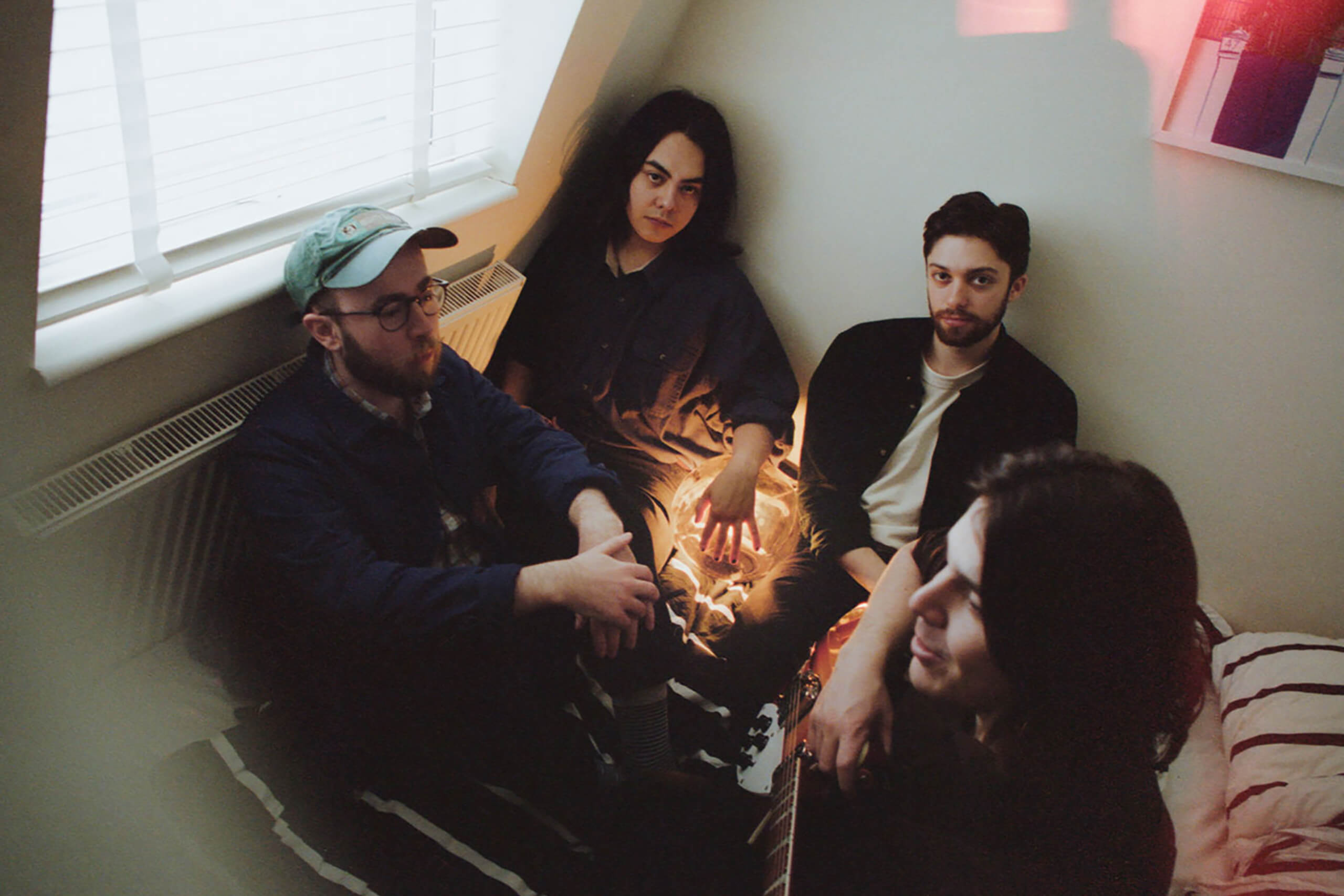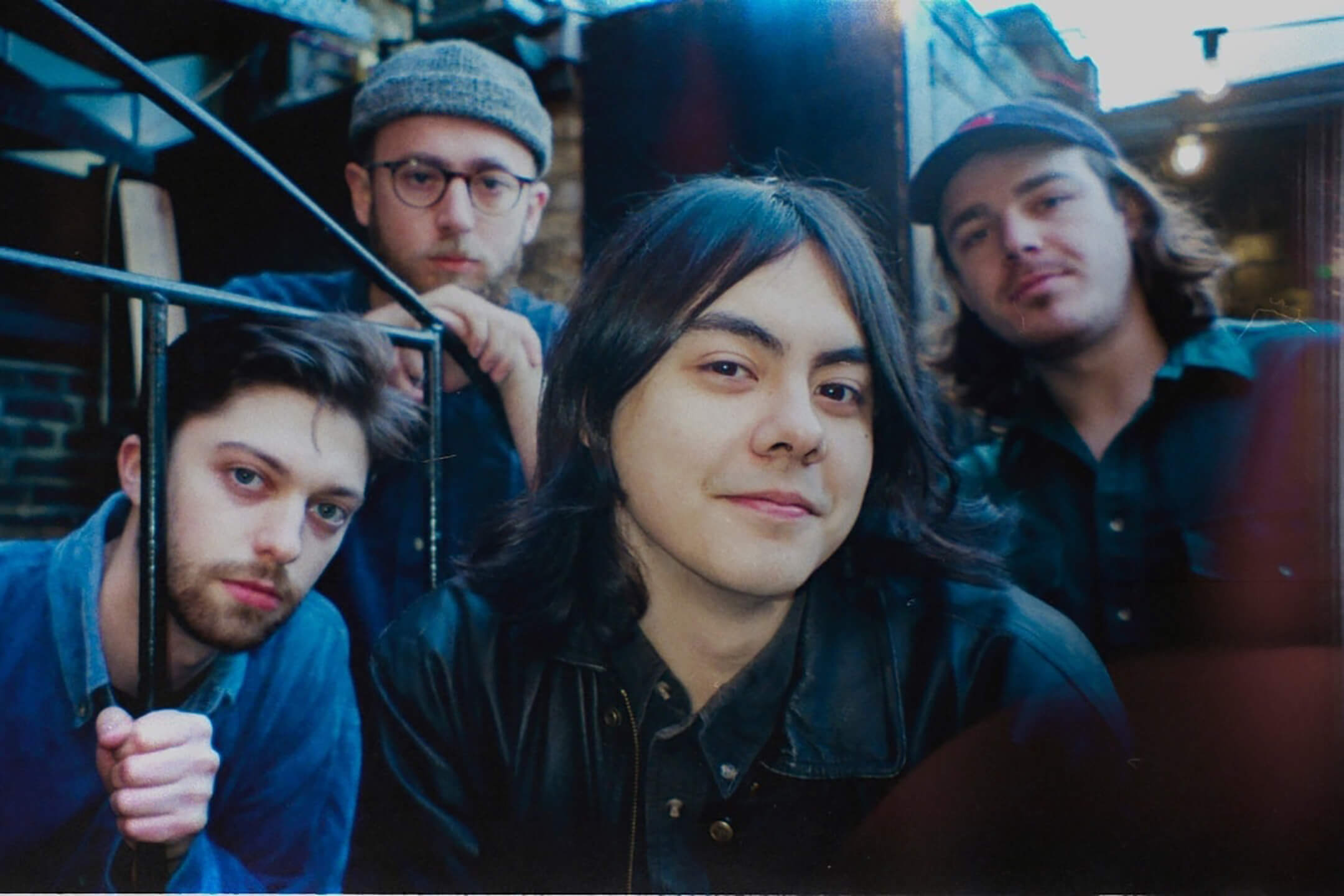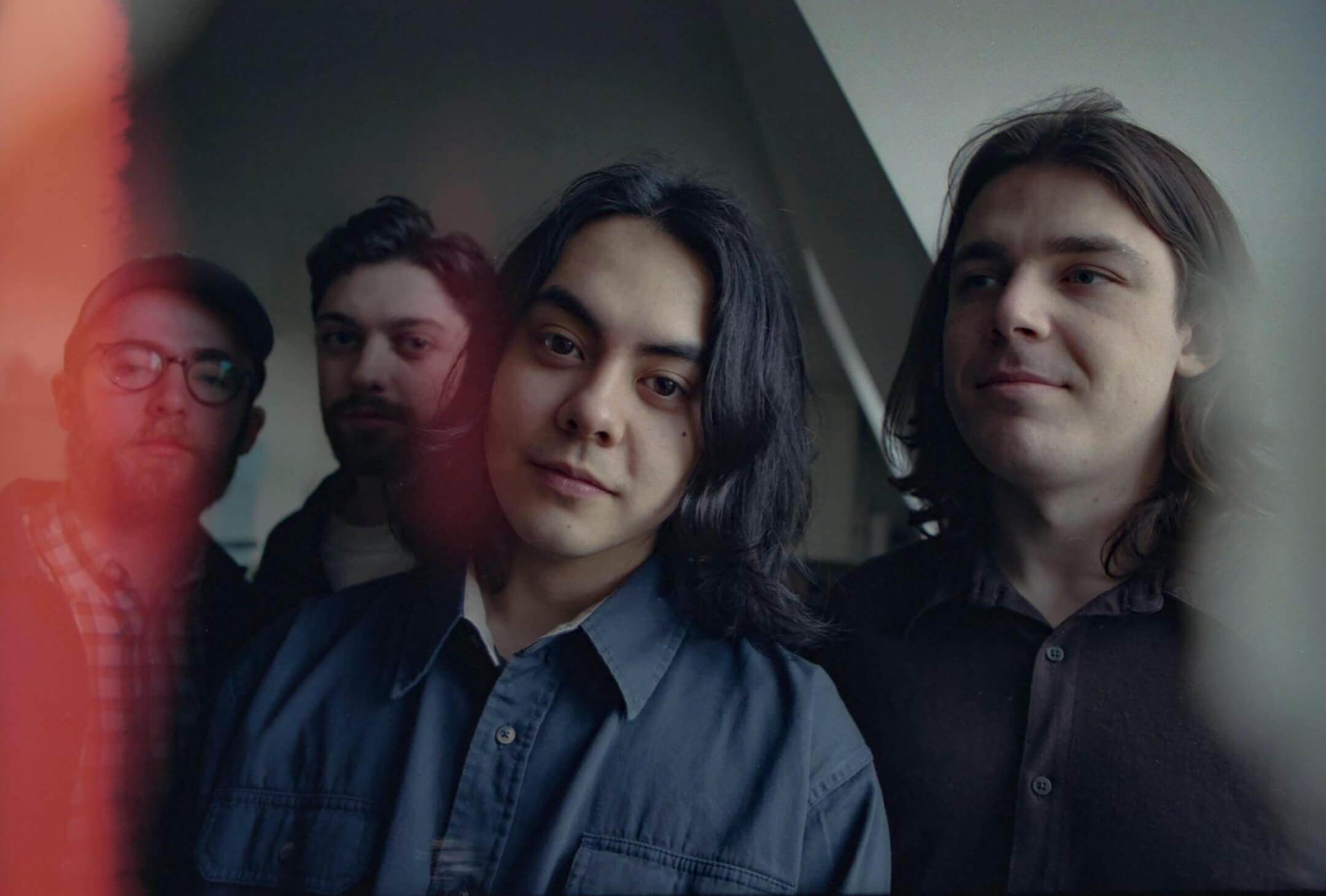Introducing… Honey Lung, a London four-piece ready for 2020’s alt-rock revival
From being locked into a room and forced to listen to My Bloody Valentine, to no longer hiding behind effects, guitarists Jamie Batten and Harry Chambers talk about the band’s formation and future.

Image: Timothy Casten
“I’d been playing in a few bands in London after I moved down from up north,” says Harry Chambers, recounting how he became a guitarist in up-and-coming indie-rock quartet Honey Lung. “I was just scrolling through Gumtree, and I found this advert that said: ‘You have to like Sparklehorse, and eating sushi’, and thought, ‘Alright, yeah. Let’s do it.” It turned out to be the right move. Because three weeks later, Harry was playing at the UK’s Latitude Festival.
That was in 2018. The momentum that Chambers found himself caught up in wasn’t just a product of luck. From their beginning, Honey Lung have been one of the hardest-working bands in the scene, playing shows relentlessly across the UK, and – before the pandemic-that-shall-not-be-named – making their name a staple of festival posters both big and small. Most recently, they’ve put out their debut EP Postmodern Motorcade Music on Big Scary Monsters, a collection of five clever, catchy and heartfelt tracks that follows a smattering of singles released since 2017.
Chambers’ induction into the band crystallised its lineup. Before him, a revolving door of members would hold onto bass and second-guitar duties. But now, as singer-guitarist Jamie Batten explains, “This lineup is definitely the lineup.” They’ve found their creative groove together: “We’re happy with our songwriting process as it is; we don’t need anyone to come in to change that.”
Honey Lung formed when Batten and drummer Omri Covo were just 19, evolving out of their previous project, Flood, “a weird noise-rock/shoegaze project which was nothing really. It was just OK”, Batten explains. “I wrote six songs so we could play live. I think we played two shows, then the rest of the band quit, except Omri.”
Their first shows as Honey Lung were played at Trinity, a small venue in Harrow, London. They effectively had a residency at one point, playing there every weekend. “That was our local place to play, back in the day,” Batten reminisces. “It was just where a lot of the bands in Harrow hung out, I mean most of them are probably broken up.”
While Chambers notes that English indie-pop band Bastille used to frequent the venue, Trinity was just a place for fledgling bands to gain a following: “It was a cool place to be in a band when you’re quite small. We had a nice little supportive scene going.”
“I thought I was so cool because I could play the solo to Freebird. I was wrong”
Honey Lung fed off that supportive, underground environment, forming a sound that displays a deep appreciation for their indie-rock forebears. The aforementioned Sparklehorse are just one of the many bands that codify Honey Lung’s eclectic influences.
It paints a promising future for the band. Over the last few years, the 1980s has come back to the fore in pop culture: from the nostalgia-soaked Stranger Things and IT to throwback pop such as Dua Lipa’s Future Nostalgia, there’s been a revival of 80s aesthetics in the 2010s.
This is no coincidence. There’s a theory that nostalgia works in 30-year cycles, and so in that respect, a band like Honey Lung are ahead of the curve: the quartet are readying their Jazzmasters for a resurgence of 1990s alt-rock – think the noisy, textural soundscapes of Sonic Youth and My Bloody Valentine married with the playful songwriting of American Football and Dinosaur Jr.
The pull of alt-rock and underground music drew both Batten and Chambers away from the classic rock that many guitarists cut their teeth on. Batten got an electric when he was 12, after learning classical guitar for four years: “I used to play a lot of Deep Purple, and classic rock – my dad got me into that stuff. Oh, and Muse I guess. Was Muse cool?”
Batten then headed off to music college, but quickly realised that he needed to up his ‘cool’ game. “I didn’t know any of the bands the kids there were into. I was such a loser, I thought I was so cool because I could play the solo to Freebird or whatever. I was wrong. I started listening to The Smiths, Dinosaur Jr. and My Bloody Valentine.”
This alt-rock awakening can be boiled down to one particularly notable incident. “I sort of had a lecture on My Bloody Valentine,” the guitarist recalls. “When I was 16, our teacher came in and said ‘My Bloody Valentine are getting back together for a record’. And we all said, ‘Uh… what? Who is that?’
“So he cancelled the whole class and said, ‘We’re going to have a lecture on Loveless right now. We’re going to listen to all of the tracks’. He slammed the volume right up, saying, ‘You can’t listen to this quietly’.”
Chambers similarly began playing “the usual Guns N’ Roses, and loads of Britpop”. But he had a somewhat less ‘alternative’ musical education than his bandmate: “I went to a very straight-laced school,” he explains. “I remember doing A-Level music and playing Jimi Hendrix at this little old lady examiner in a wood-panelled room. It was not School Of Rock, [but] the other one with Gene Simmons where he gets all of the kids into a band. That kind of thing.” He’s referring, of course, to Gene Simmons’ Rock School, a British reality TV show where the Kiss bassist had to form a rock band from a group of classically trained students who were apathetic to rock ’n’ roll.
“We realised that to be a great live band you’ve gotta play your instruments well. We were hiding behind our effects when we started”
Chambers got more engaged in the DIY scene and underground bands when he moved out for university. The appeal came in the form of a completely different approach to guitar music: where it’s more about the song than a riff. “I love the Brian Jonestown Massacre,” he says. “I’d rather listen to any of those guys play one note on a 12-string for half an hour over any solo. And I’ve gotten big into the folk stuff, I listen to a lot of Bert Jansch’s finger-picking stuff, that has the same sort of minimalist sensibilities that come into what we do.”
It took time for the band to land on that minimalist approach – especially when it came to gear. Both Batten and Chambers admit that earlier on, they fulfilled the stereotype of shoegaze bands lugging about monumental pedalboards. “I used to have all kinds of shit,” says Batten, “most of which I’d switch on for about one second of a single song. At some point, I realised it was too much.”

Chambers is the one producing more of the textures live, with his counterpart focusing on the core rhythm playing. So it was no surprise that Harry, too, was caught in the throes of gear-acquisition syndrome: “The first tour that I did with Honey Lung I think I got a bit carried away with myself,” he says. “I had this huge board with phasers and a multi-amp setup with a drone going through one, split signal and all that stuff. I just realised that it was a bit silly, and just not where we’re going, so similarly I’ve scaled my board way down, and have started trying to just use clean tones where I can.”
After going overboard with effects, both guitarists began instead to focus on the tried-and-tested tones of pushed tube amps. “The amp situation was our big realisation. If we got our amps into that sweet spot, we could really get the tone we wanted,” says Batten, adding that he used Tube Screamers to push his amp’s front end. “I didn’t know how to use Tube Screamers when I started playing. I used to have my amp volume at one and turn the drive up. Completely the wrong way to do it. You just want it to push the front end ever so slightly, into that sweet spot.”
“If we had three days in a studio, there’s a pressure to thrash out the loudest solo – there’s no room to experiment”
Chambers concurs, “It’s the playing, in the end. We realised that if we want to be a great live band you’ve gotta play your instruments really well. We were hiding behind our effects when we started.”
His tone comes down to an Electro-Harmonix SuperEgo and an Origin Effects Cali76, the latter of which he spent “far too much money on”. But acquiring it was an Eureka moment for him: “For ages, I thought, ‘Oh, a compressor doesn’t do that much – I’ll just get all the fuzz pedals I can’,” he says. “And then I switched the Cali76 on, and thought, ‘Holy shit, we really can just let our amps do the talking’.”

The actual amps doing said talking are Batten’s Fender Vibraluxe and Chambers’ Fender Hot Rod Deluxe, both of which break up at their ideal stage volumes, “just when the sound guy asks you to turn down”, the former says.
This straightforward approach to gear has allowed their songwriting to mature, too. Harry explains that Postmodern Motorcade Music marks a bridge between how they use to approach things, and where they want to go – making things more about the songs than about the riffs.
“Originally, we would write everything starting with the guitars and write the rest of the instrumentals, then add the vocals later,” says Batten. “It was really, really guitar-driven at the start, based around getting the right sound with the pedals and the amp, and getting that idea to format the song around.
“We’ve kind of flipped our roles around – it’s now a ‘song is king’ approach”
“It’s less about being exclusively guitar-driven now. We’re trying to push it towards the melody and the chords, and then having the guitars serve that. We’ve kind of flipped our roles around – it’s now a ‘song is king’ approach. It’s working out nicely, actually – I’ve been doing a lot of writing over quarantine, just sitting down with an acoustic Yamaha, strumming out some chords and writing down lyrics. And that’s the way we want to keep doing things.”
Historically, the band haven’t been the most prolific in terms of recorded output. Not because they didn’t want to, but because they “didn’t really know the right way to go about things”, says Batten. “It’s a really great thing to be able to pump out music online, like Car Seat Headrest or Alex G – those artists that can put out two albums a year.”

But Honey Lung are looking to change that by recording their new material at home, rather than going into a studio – not just because of any current pandemic-related closures, but for the extra freedom that it offers. They want to be a band that “puts out a record a year”, according to Batten, and the traditional recording studio environment wasn’t one that gelled with their approach to songs.
“Recording by ourselves, we had so much more time,” Chambers says, referring to the sessions that led to Postmodern Motorcade Music. Doing it at home “fed into making the music more textural, more mature”, he continues. “If we had three days in a studio – what we used to have – there’s a pressure to thrash out the loudest solo, right then, and there’s no room to experiment.”
Batten is keen to put the band’s knowledge of gear to good use. He says now it’s possible to use gear-nerdery to learn how to “do all of the stuff you need to do to make a record”, not just find the perfect guitar tone. Financially, it works for them too, as Jamie posits: “There’s not as much money in the music industry anymore.”
Notably for Honey Lung, this means that “there aren’t those big deals that the bands in the 90s signed”. But they don’t seem too concerned by that. They’ve approached recording and garnered a following with a refreshing confidence, freed from the expectations of any sort of rock ’n’ roll ideal. This is a band ready and willing to make their own way in music, and their course is well-plotted. Roll on the 30-year cycle.
Postmodern Motorcade Music is out now on Big Scary Monsters.
